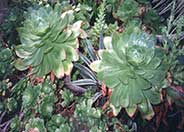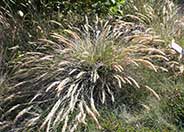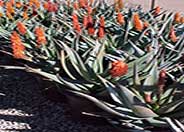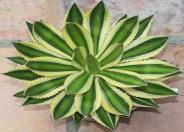
Common name:Aeonium Succulents
Botanical name:Aeonium species
These plants are one of the most useful succulents, due to their decorative effects and sculpturesque quality. The branched stems hold a wide rosetta of either light green or purple leaves. The flowers appear in long, clustered form. They need some shade in hotter areas. Prostrate forms are low-growing, and spreading.

Common name:Reed Grass
Botanical name:Calamagrostis foliosa
This tufted, perennial bunchgrass forms a beautiful, dense mound of gray green leaves that reach 2' tall, with showy arching flower stalks to 3' tall. Reed Grass leaves assume an attractive purple coloration in the fall and winter. This evergreen should be grown under sun, with little or no summer watering required. Tall grasses are highly combustible.

Common name:Little River Wattle
Botanical name:Acacia cognata 'Cousin Itt'
This low shiny ground cover has a low mounding form. It does well in both hot inland or coastal settings, needing little water or care once established. It is a great addition to Mediterranean style gardens, excellent for hillside plantings, rock gardens, mass plantings and with dry creek beds. It is small in stature growing less than 2 feet tall and 4 feet wide. It looks like side-ways bamboo.

Common name:Bitter Aloe
Botanical name:Aloe ferox
Cape aloe forms a dense 2'-3' clump of muted, green leaves borne on a tall trunk eventually to 12'. It has thick, wide fleshy leaves edged with prominent reddish-brown teeth. Dried leaves persist on the plant and offer sunburn protection. In late winter or early spring, the plant produces 3' candelabra spikes of intense orange red or even yellow tubular flowers. It grows in full sun to part shade. It suffers in reflected heat in the low desert. It is a South African native.

Common name:Quadricolor Century Plant
Botanical name:Agave lophantha 'Quadricolor'
This Texas native is found on gravelly limestone and rocky areas. Leaves are an open rosette form, fairly flat and sword-shaped, green in color with spines along the margins. This plant reaches 2' tall and 3' wide. Occasionally, this plant sends up a tall spike 12' tall with greenish yellow flowers. This marks the death of the plant but there are usually offspring close by. Plant in full to part sun with well draining soil. It is drought tolerant once it's established.
Designer: Linda McSwain (retired)
Photographer: Vicki Anderson
Practice grass-cycling by leaving short grass clippings on lawns after mowing, so that nutrients and organic matter are returned to the soil.
Drip and other smart irrigation delivers water directly to roots, allowing no excess water for weeds.